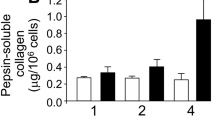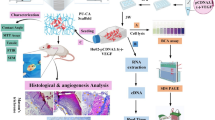In this study, we aimed to increase crosslinking in collagen and elastin in the extracellular matrix through overexpression of lysyl oxidase (LO) in order to improve mechanical strength in dermal wounds during healing. We had used a gene activated matrix (GAM) approach to locally deliver plasmid DNA (pDNA) complexed with polyethylenimine (PEI) in collagen gels at the wound site for localized and sustained transfection of cells involved in the healing process. We first demonstrated in vitro that PEI-pDNA complexes in collagen gels could be taken up and expressed by cultured fibroblasts for at least 20 days. In vitro studies showed that fibroblast-seeded GAMs with the LO transgene exhibited over a 3-fold increase in mechanical strength as compared with a green fluorescent protein (GFP)-transgene control. Addition of an inhibitor of LO abolished this increase. We applied this system in a rat dermal wound healing model and showed that treatment with LO-producing GAMs led to significantly enhanced mechanical strength of the wound site.








Similar content being viewed by others
REFERENCES
Ando, J., H. Tsuboi, R. Korenaga, K. Takhashi, K. Kosaki, M. Isshiki, T. Tojo, Y. Takada, and A. Kamiya. Differential display and cloning of shear stress-responsive messenger RNAs in human endothelial cells. Biochem. Biophys. Res. Commun. 225(2):347–351, 1996.
Boak, A. M., R. Roy, J. Berk, L. Taylor, P. Polgar, R. H. Goldstein, and H. M. Kagan. Regulation of lysyl oxidase expression in lung fibroblasts by transforming growth factor-beta 1 and prostaglandin E2. Am. J. Respir. Cell Mol. Biol. 11(6):751–755, 1994.
Bohl, M. K. S., S. J. Leibovich, P. Belem, J. L. West, and L. A. Poole-Warren. Effects of nitric oxide releasing poly(vinyl alcohol) hydrogel dressings on dermal wound healing in diabetic mice. Wound Repair Regen. 10(5):286–94, 2002.
Cohen-Sacks, H., V. Elazar, J. Gao, A. Golomb, H. Adwan, N. Korchov, R. J. Levy, M. R. Berger, and G. Golomb. Delivery and expression of pDNA embedded in collagen matrices. J. Control Release 95:309–320, 2004.
Csiszar, K. Lysyl oxidases: a novel multifunctional amine oxidase family. Prog. Nucleic. Acid Res. Mol. Biol. 70:1–32, 2001.
Elbjeirami, W. M., E. O. Yonter, B. C. Starcher, J. L. West. Enhancing mechanical properties of tissue-engineered constructs via lysyl oxidase crosslinking activity. J. Biomed. Mater. Res. A. 66(3):513–521, 2003.
Fang, J., Y. Y. Zhu, E. Smiley, J. Bonadio, J. P. Rouleau, S. A. Goldstein, L. K. McCauley, B. L. Davidson, and B. J. Roessler. Stimulation of new bone formation by direct transfer of osteogenic plasmid genes. Proc. Natl. Acad. Sci. U S A. 93(12):5753–5758, 1996.
Florea, B. I., C. Meaney, H. E. Junginger, and G. Borchard. Transfection efficiency and toxicity of polyethylenimine in differentiated Calu-3 and nondifferentiated COS-1 cell cultures. AAPS Pharm. Sci. 4(3):E12, 2002.
Gacheru, S. N., K. M. Thomas, S. A. Murray, K. Csiszar, L. I. Smith-Mungo, and H. M. Kagan. Transcriptional and post-transcriptional control of lysyl oxidase expression in vascular smooth muscle cells: effects of TGF-beta 1 and serum deprivation. J. Cell Biochem. 65(3):395–407, 1997.
Gavriel, P., and H. M. Kagan. Inhibition by heparin of the oxidation of lysine in collagen by lysyl oxidase. Biochemistry 27(8):2811–2815, 1988.
Godbey, W. T., K. K. Wu, and A. G. Mikos. Poly(ethylenimine)-mediated gene delivery affects endothelial cell function and viability. Biomaterials 22(5):471–480, 2001.
Huang, Y. C., C. Simmons, D. Kaigler, K. G. Rice, and D. J. Mooney. Bone regeneration in a rat cranial defect with delivery of PEI-condensed plasmid DNA encoding for bone morphogenetic protein-4 (BMP-4). Gene Ther. 12(5):418–426, 2005.
Kagan, H. M., and W. Li. Lysyl oxidase: Properties, specificity, and biological roles inside and outside of the cell. J. Cell Biochem. 88(4):660–672, 2003.
Kyriakides, T. R., T. Hartzel, G. Huynh, and P. Bornstein. Regulation of angiogenesis and matrix remodeling by localized, matrix-mediated antisense gene delivery. Mol. Ther. 3(6):842–849, 2001.
Lechardeur, D., K. J. Sohn, M. Haardt, P. B. Joshi, M. Monck, R. W. Graham, B. Beatty, J. Squire, H. O’Brodovich, and G. L. Lukacs. Metabolic instability of plasmid DNA in the cytosol: a potential barrier to gene transfer. Gene Ther. 6(4):482–497, 1999.
LeGrand, E. K. Preclinical promise of Becaplermin (rhPDGF-BB) in wound healing. Am. J. Surg. 176(Suppl 2A):48–54, 1998.
Nelson, J. M., R. F. Diegelmann, and I. K. Cohen. Effect of β-aminopropionitritle and ascorbate on fibroblast migration. Proc. Soc. Exp. Biol. Med. 188:346–352, 1988.
Robson, M. The role of growth factors in the healing of chronic wounds. Wound Rep. Reg. 5:12–17, 1997.
Sagara, K., and S. W. Kim. A new synthesis of galactose-poly(ethylene glycol)-polyethylenimine for gene delivery to hepatocytes. J. Control Release. 79(1–3):271–281, 2002.
Stocum, D. L. Wound Repair, Regeneration and Artificial Tissues. Austin: R.G. Landes Company, 1995, pp. 15.
Sugiyama, M., M. Matsuura, Y. Takeuchi, J. Kosaka, M. Nango, and N. Oku. Possible mechanism of polycation liposome (PCL)-mediated gene transfer. Biochim. Biophys. Acta. 1660(1–2):24–30, 2004.
Tang, S. S., P. C. Trackman, and H. M. Kagan. Reaction of aortic lysyl oxidase with beta-aminopropionitrile. J. Biol. Chem. 258(7):4331–4338, 1983.
Thomas, M., Q. Ge, J. J. Lu, J. Chen, and A. M. Klibanov. Cross-linked small polyethylenimines: while still nontoxic, deliver DNA efficiently to mammalian cells in vitro and in vivo. Pharm. Res. 22(3):373–380, 2005.
Thomas, M., and A. M. Klibanov. Non-viral gene therapy: polycation-mediated DNA delivery. Appl. Microbiol. Biotechnol. 62(1):27–34, 2003.
Trackman, P. C., D. Bedell-Hogan, J. Tang, and H. M. Kagan. Post-translational glycosylation and proteolytic processing of a lysyl oxidase precursor. J. Biol. Chem. 267(12):8666–8671, 1992.
Udupa, S. L. Inhibition of lysyl oxidase by isoniazid and its effect on wound healing. Indian J. Exp. Biol. 33(4):278–280, 1995.
Wiseman, J. W., C. A. Goddard, D. McLelland, and W. H. Colledge. A comparison of linear and branched polyethylenimine (PEI) with DCChol/DOPE liposomes for gene delivery to epithelial cells in vitro and in vivo. Gene. Ther. 10(19):1654–1662, 2003.
ACKNOWLEDGMENTS
Research funding was provided by National Institutes of Health (RO1HL-60485).
Author information
Authors and Affiliations
Corresponding author
Rights and permissions
About this article
Cite this article
Lau, YK.I., Gobin, A.M. & West, J.L. Overexpression of Lysyl Oxidase to Increase Matrix Crosslinking and Improve Tissue Strength in Dermal Wound Healing. Ann Biomed Eng 34, 1239–1246 (2006). https://doi.org/10.1007/s10439-006-9130-8
Received:
Accepted:
Published:
Issue Date:
DOI: https://doi.org/10.1007/s10439-006-9130-8




